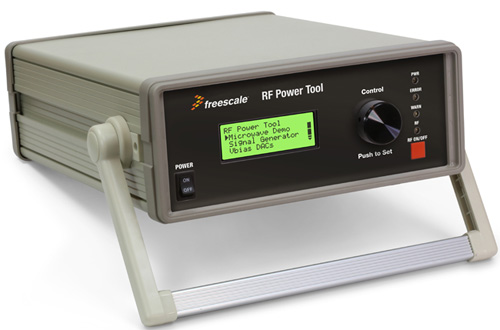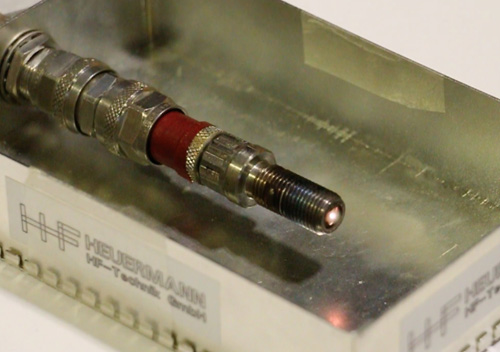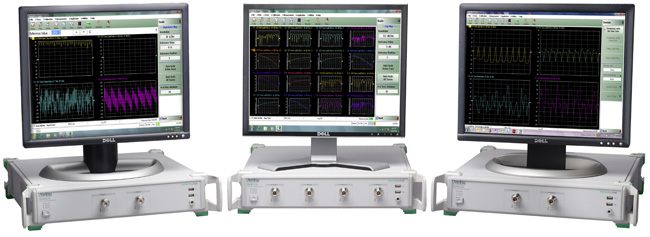7 Noteworthy Technologies From IMS2014

At the 2014 IEEE MTT International Microwave Symposium earlier this month, I had the opportunity to speak with the event’s general chair, Dr. Larry Dunleavy, about the state of the RF and microwave design industry. While he acknowledged that it is a time of relative uncertainty — due in large part to constrained military budgets and conservative fiscal forecasts for 2014 — he also pointed out that there are plenty of emerging markets where RF and microwave technology is making a significant impact. With the Internet of Things (IoT) driving innovation in burgeoning markets like automotive and healthcare and the development of 5G pushing wireless technology to further heights, there was good reason for nearly 600 companies to flock to the IMS2014 exhibition in Tampa, Fla.
As the largest event in the industry, IMS is the place where component, subsystem, and service providers make their biggest annual announcements and showcase their latest, most exciting technologies. In case you missed the show, here is a selection of some of the innovative new products that were on display at IMS2014.
Gallium Nitride (GaN) Power Amplifier
To say that GaN technology was popular at IMS2014 would be a grievous understatement. Countless companies around the exhibition floor were demonstrating the latest technological developments in GaN, as the material is becoming an industry staple for many products. Particularly popular GaN products on display included wideband power amplifiers (PAs) and low-noise amplifiers (LNAs).
With the release of its second generation of monolithic microwave integrated circuit (MMIC) GaN PAs, Northrop Grumman was among the companies that announced new GaN products at IMS. Designed for use in point-to-point digital communication links and SATCOM terminals, the APN 228 and APN 229 both operate at the 27 to 31 GHz range.
The APN 228 and 229 PAs measure in at 16.0 mm2 and 7.41 mm2 respectively, and both boast especially high levels of saturated output power — 41.2 dBm and 39 dBm. Also noteworthy were their high levels of linear gain (19.5 dB, 20 dB) and power added efficiency (PAE) numbers (27 percent and 30+ percent).
If you want to see high linearity in action, stop by Booth 1039 to see @northropgrumman's GaN PA #IMS2014 pic.twitter.com/3h3h9HGB5Y
— RFGlobalnet (@RFGlobalnet) June 4, 2014
24-Port Vector Network Analyzer (VNA)
Even though Rohde & Schwarz (R&S) technically released its ZNBT product about a month prior to IMS2014, it is tough not to mention the first VNA to offer 24 ports. The VNA covers the 9 KHz to 8.5 GHz range and enables large operations — like mobile phone manufacturers — to measure multiple DUTs (devices under test) in parallel for more efficient operation. Perhaps most notably, the R&S ZNBT can cover all 576 S-parameters at 201 frequency points in less than 260 ms — making it ten times faster than any previous R&S VNA.
Just got to see @RohdeSchwarz's new VNA with 24 test ports at #IMS2014. Check it out at Booth 1439! pic.twitter.com/4G0ewo580R
— RFGlobalnet (@RFGlobalnet) June 3, 2014
A Replacement For The Traditional RF Workbench
At IMS2014 many companies released products designed to help facilitate the prototyping process for engineers. These products included components with higher levels of integration, more comprehensive simulation software tools, and simplified test and measurement solutions —all geared towards reducing the strain and risks involved with developing a new product.
Freescale was one of the companies that introduced a new product meant to aid engineers in the design process. Its newly developed RF Power Tool System was created to help simplify the average work bench, which, for many engineers, comprises numerous pieces of test equipment, takes up a lot of lab space, and can make for an exorbitant capital investment.

The system includes the RF Power Tool generator instrument, an evaluation module, and a Windows executable graphical user interface (GUI). It operates in the 1 MHz to 3 GHz frequency range, and, using pulse or continuous wave modulation, it can provide a comprehensive amount of real-time measurements — including temperature, voltage, current, efficiency, and drive power. In addition, application specific components can be used in conjunction with the tool, including a high power supply, a heat sink, and a PA to load connector cable.
Handheld Field Analyzers
Many of the products highlighted at IMS2014 were upgrades and revisions of existing technologies. One such product line that attracted a lot of attention this year was Agilent’s line of handheld spectrum analyzers — the FieldFox handheld analyzer in particular. The FieldFox family of analyzers covers frequencies ranging from RF to microwave, and combines the capabilities of a VNA, a spectrum analyzer, and an antenna analyzer in a portable, durable, 3 kg package. Aside from its multi-functionality, the FieldFox analyzers also meet military specifications for durability and robustness along with specifications for use in explosive environments.
These @agilent handheld spectrum analyzers keep getting better. Check them out at Booth 1133! #ims2014 pic.twitter.com/BbCM7ixIoL
— RFGlobalnet (@RFGlobalnet) June 3, 2014
SDARS Integrated LNA And Filter
Avago had an interesting prototype on display that fit right in with the theme of engineer-centric designs that facilitate the prototyping process. The company’s prototype — what could potentially be the industry’ first integrated LNA and filter — was designed to enable SDARS (Satellite Digital Audio Radio Service) coexistence with both cellular and Wi-Fi. While it is still under development, the 5 x 5 mm2 package could help RF design engineers working on future mobile devices, allowing for a reduction in part counts and simplified integration.
An industry-first integrated LNA and filter from @Avagotech. Check it out at Booth 1525! #IMS2014 pic.twitter.com/LD9sjXIExN
— RFGlobalnet (@RFGlobalnet) June 4, 2014
Automotive RF Plasma Ignition
As the RF industry continues to evolve, it is becoming clear that the automotive industry is going to be a key market. (Just contrast the number of vehicles on the road with the number in the air, and you can get a gauge of how big the opportunity really is.) While the current emphasis is on developing “smarter” cars with collision avoidance radar and additional active safety features, there are other innovative areas where RF technology can penetrate the automotive industry.

I saw one such technology, an automotive RF plasma ignition, when I visited NXP’s booth. Improving on its portfolio of RF plasma technology, the team at NXP is optimistic in the long-term adoption of this alternative to traditional ignition systems. Driven from a 200 W PA at 2.45 GHz, RF plasma ignition could lead to a 10 to 15 percent reduction in fuel consumption and volatile organic compound (VOC) emissions. With environmental and cost-cutting benefits like those, it’s easy to see why NXP believes the technology could thrive in the future.
Cost-Effective VNAs
Some of the biggest news to drop at IMS2014 was the release of Anritsu’s new “ShockLine” VNAs — a line of products developed to enable engineers to measure two- and four-port devices without having to invest in high-end, expensive VNAs when only basic measurements are necessary. Designed for testing passive devices like cables, connectors, filters, and antennas, these cost-effective VNAs are especially relevant for education applications where students are just learning how to take measurements.

At the show, Anritsu featured two members of the ShockLine VNA family, one that covers the 50 kHz to 4.5 GHz frequency range and another that covers up to 8.5 GHz. The cost-effective product, according to Anritsu, is enabled by the company’s proprietary VNA-on-a-chip technology.
Watching The Waves
This selection of products is by no means an exhaustive list of all of the great technology that was on display at IMS2014. With the advent of the IoT, the development of 5G, and the burgeoning healthcare and automotive markets, the RF industry is poised to enter a transformative period. The aforementioned products are just some of those that are paving the way for the next generation of wireless innovation.
For comprehensive post-show analysis, check out our IMS2014 Resource Center where you can catch up on all of the news and videos from the show.
Did you travel to IMS2014? If so, what was the most exciting technology you saw? Share your thoughts below, and let us know what you thought about the show.
